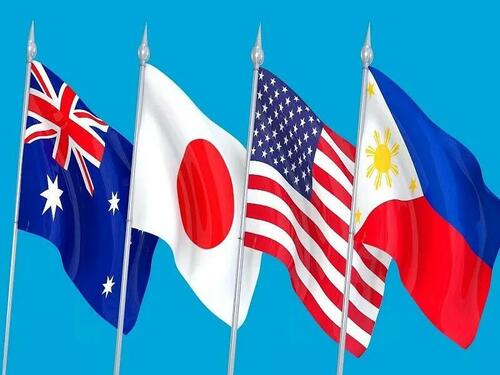
Индия будет Присоединяйся Азиатский «отряд»?
Автор Эндрю Корыбко через подстэк,
Начальник штаба Вооруженных сил Филиппин Ромео Браунер пригласил Индию присоединиться к азиатскому «Отряду», выступая на последнем ежегодном форуме по безопасности Raisina Dialogue в Дели. Этот неологизм, как сообщается, был придуман чиновниками Пентагона прошлой весной для обозначения многостороннего сотрудничества между США, Австралией, Японией и Филиппинами. Браунер предположил, что Индия может участвовать в обмене разведданными о своем «общем враге» Китае. Вот пять справочных брифингов:
16 июня 2023 года: «Нарождающийся трехсторонний альянс США с Японией и Филиппинами интегрируется в AUKUS+»
27 января 2024 года: «Почему Россия разрешает Индии экспортировать на Филиппины совместно произведенные сверхзвуковые ракеты? "
29 марта 2024 года: «Поддержка Индией Филиппин в ее морском споре с Китаем не связана с США»
6 мая 2024 года: «Новое азиатское подразделение США имеет стратегические последствия для Индии»
* 18 февраля 2025 года: «Последний саммит Моди-Трампа продемонстрировал многостороннюю стратегию Индии»
Подводя итог, можно сказать, что Филиппины становятся центральным элементом запланированного США «Пивот (назад) в Азию» для более мускулистого сдерживания Китая, который де-факто расширит альянс AUKUS по всему региону. Индия является одним из основателей «четверки» наряду с США, Австралией и Японией, но она яростно защищает свою с трудом заработанную стратегическую автономию и не будет подчиняться США, как две другие, и Филиппины будут, несмотря на свои проблемы с Китаем, поэтому она не была включена в «отряд».

Индия и Китай также вступили в сближение после того, как их лидеры встретились в кулуарах октябрьского саммита БРИКС в Казани, причем США непреднамеренно несут ответственность за этот процесс, как объяснялось здесь в то время. Однако возвращение Трампа на пост президента изменило стратегические расчеты Индии, поскольку он жестко относится к Китаю и отдает приоритет «Пивот (назад) в Азию». Великая стратегическая переориентация США на эту часть Евразии придаст Индии большую роль в американском планировании.
Поэтому индийские политики могут увидеть ценность в обмене разведданными о Китае со своим филиппинским партнером, который является одним из союзников США по взаимной обороне, через формат «Отряда». Это может даже заложить основу для нового альянса по обмену разведданными «Пять глаз». Дальнейшее приобщение Индии к планированию Пентагона в отношении Китая до тех пор, пока Индия сохраняет свою с трудом заработанную стратегическую автономию все это время, также может привести к уменьшению торгового и тарифного давления со стороны Трампа или так, что индийские политики могут подумать.
С другой стороны, Индия может рискнуть спровоцировать Китай и тем самым еще больше осложнить и без того трудное сближение, если Пекин интерпретирует это как сигнал о предстоящем подчинении Дели Вашингтону, и в этом случае их пограничная напряженность может снова ухудшиться, и прогресс прошлой осени будет отменен. Двусторонний обмен разведданными с Филиппинами также, вероятно, будет рассматриваться Китаем как провокационный, но он все равно будет качественно отличаться от фактического или формального включения Индии в «Отряд».
Соответственно, одна из возможностей заключается в том, что Индия всесторонне наращивает свое сотрудничество в области безопасности с Филиппинами без многостороннего участия в этом «Отряде», одновременно сообщая США о том, насколько чувствителен этот вопрос в отношении Китая. Взяв золотую середину таким образом, Индия может остаться в благодати США, несмотря на сохранение дистанции между собой и «Отрядом», что позволит избежать восприятия того, что она присоединяется к возглавляемому Америкой антикитайскому альянсу за счет своего суверенитета.
Сегодня Индия должна пройти тонкую грань между Китаем и «Отрядом» в контексте того, что Трамп придает приоритетное значение США. «Назад в Азию» из-за того, что эта большая стратегическая переориентация влечет за собой интересы национальной безопасности Индии. Оставаясь слишком далеко от возглавляемых Америкой инициатив, Вашингтон может считать их недружественными, а Пекин — слишком близкими к ним. Будет трудно найти баланс, но если и есть какая-то страна, которая может успешно объединиться, то это Индия.
Тайлер Дерден
Солнце, 03/30/2025 - 23:20















